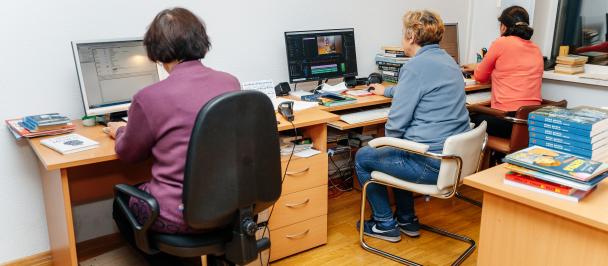The number of Ukrainians who use electronic government services increased by 7 percent over the year.
Photo: Kostyantyn Chernichkin / UNDP Ukraine
Kyiv, 24 January 2022 – The number of Ukrainians who used electronic government services from September 2020 through September 2021 has gone up, from 53 percent to 60 percent. This is evidenced by a sociological study conducted by the Kyiv International Institute of Sociology in September 2021 at the request of the UN Development Programme (UNDP), with support from Sweden. Thus, as of September 2021, three out of five Ukrainians had used electronic services over the year.
Ukrainians most often use the Diia mobile application or portal, with the number of users more than doubling – from 13 percent in 2020 to 30 percent in 2021. Other popular services include those related to the use of private vehicles (15 percent), applying for passports or other services provided by the State Migration Service (14 percent), applying for subsidies (13 percent), applying for pensions (11.5 percent), private entrepreneurship (11 percent), taxation (10.5 percent), and obtaining information from state registries (10 percent).
Last year, the most active users of electronic government services were men, young people, residents of large cities and people with a higher education. The most significant “gap” in use of these services is seen in people of various ages: 80 percent of 18 to 29 year olds had used at least one service, while only 32 percent of those older than 70 had done so.
The Ministry of Digital Transformation aims to build the most convenient state in terms of service quality. That is why it is important for the ministry to monitor users’ feedback and thoughts, emphasized Mstyslav Banik, Head of Digital Services Development at the Ministry of Digital Transformation at a presentation of the survey, which took place today in Kyiv.
“This survey has revealed that the use of electronic services is rising. More people are now using Diia – its portal has 13.5 million users, and the mobile application is used by the same number of people. We are creating more and more opportunities for Ukrainians to use the existing services – there are already 72 public electronic services available on the Diia portal, and nine public electronic services and 15 digital documents are available in the Diia mobile application. We are aware of where we need to put in more effort and on which areas we need to focus to make sure we apply an inclusive approach to creating government services,” he said.
Overall, 69 percent of respondents use the Internet every day for at least three hours. Another 16 percent use the Internet less regularly – no more than two to three hours every week. What is more, the length of Internet use decreases with age: 94.5 percent of respondents under 30 years old use the Internet every day, while for those over 70 this figure is only 27 percent. Some 13.5 percent of respondents said they did not use the Internet at all.
Of those who used electronic government services, 78 percent described their experience as “rather positive” or “very positive”. Moreover, 54 percent of those surveyed believe that it is more convenient to obtain electronic services online, while 11 percent held that it was more convenient for them to obtain services through TSNAPs or other institutions. One out of four respondents said that both ways were convenient.
Anton Hrushetsky, Deputy Executive Director of the Kyiv International Institute of Sociology (left); Olena Ursu, UNDP Ukraine Programme Specialist, Democratic Governance (in the middle); Mstyslav Banik, Head of Digital Services Development at the Ministry of Digital Transformation (right)
Photo: Daniiar Sarsenov / Ministry of Digital Transformation of Ukraine
Anton Hrushetsky, Deputy Executive Director of the Kyiv International Institute of Sociology, said that the development of electronic services is not only a convenient way for people to obtain government services, but also a way to make service provision more transparent.
“This survey has revealed that people are very happy to use electronic services,” said Hrushetsky. “But digitalization is not only about convenience. All surveys show that Ukrainians believe corruption to be one of the top problems. Digitalization provides more safeguards against corruption, and this over time should increase public confidence in government services.”
The main reasons why some respondents did not use any electronic government services this year were the absence of need (62 percent), a lack of digital skills (22 percent) and the absence of a device that can connect to the Internet (17 percent). Last year, respondents gave the same reasons.
“UNDP, in partnership with Sweden, actively supports the Ministry of Digital Transformation of Ukraine, making efforts to make the benefits of digital transformation available to all men and women, regardless of their financial standing, level of education or place of residence,” said Olena Ursu, UNDP Ukraine Programme Specialist, Democratic Governance. “At the end of last year, UNDP helped the Ministry of Digital Transformation launch an information campaign to distribute 3 million leaflets on the possibilities of Diia and Diia.Digital Education for people aged 55+ throughout Ukraine, including in the most remote areas of the country,” said Ursu.
“The results of the survey will allow us to make informed decisions as to how to provide equal access to electronic services to all people,” Ursu said. “For instance, the second most important reason for not using electronic services for the lack of required skills (named by 22.3 percent). UNDP, together with the Swedish government will be happy to help the Ministry of Digital Transformation to overcome the challenges identified by the study, in particular through enhancing people’s digital literacy.”
Data obtained through a national representative omnibus survey correlate with the results of a national survey conducted by UNDP in Ukraine in 2020. It revealed that 47 percent of respondents had not used any electronic services over the course of one year. Most of them said that there was no need (68 percent), 24 percent lacked the required digital skills, while 21 percent had no devices that can connect to the Internet. Another nine percent used no electronic government services because they did not trust electronic documents or services, while about four percent used no such services because they did not know if the service they need was available electronically.
Background
The national study called “Thoughts and Views of the Population of Ukraine regarding Electronic Government Services” was conducted by the Kyiv International Institute of Sociology in September 2021 as part of a regular national omnibus study at the request of the “Digital, Inclusive, Accessible: Support to Digitalisation of Public Services in Ukraine Project” (DIA Support Project), which is being implemented by UNDP in Ukraine with financial support from Sweden. The survey was carried out using the computer-assisted telephone interviews (CATI) of respondents who are older than 18 and live in Ukraine, except for the temporarily non-government-controlled areas of Donetsk and Luhansk oblasts and the Autonomous Republic of Crimea and the city of Sevastopol that have been temporarily occupied according to the UN General Assembly Resolution 74/168.
The field survey lasted from 18 September through 27 September 2021. A total of 2,006 interviews were conducted. The sampling error (with a probability of 0.95 and taking into account the design effect of 1.1) does not exceed 2.4 percent for indicators close to 50 percent’; 2.1 percent for indicators close to 25 or 75 percent; 1.5 percent for indicators close to 10 or 90 percent, 1.1 percent for indicators close to 5 or 95 percent, and 0.5 percent for indicators close to 1 or 99 percent.
Media enquiries
Yuliia Samus, Communications Team Leader, UNDP in Ukraine, Yuliia.Samus@undp.org or +38 097 139 1475

 Locations
Locations





